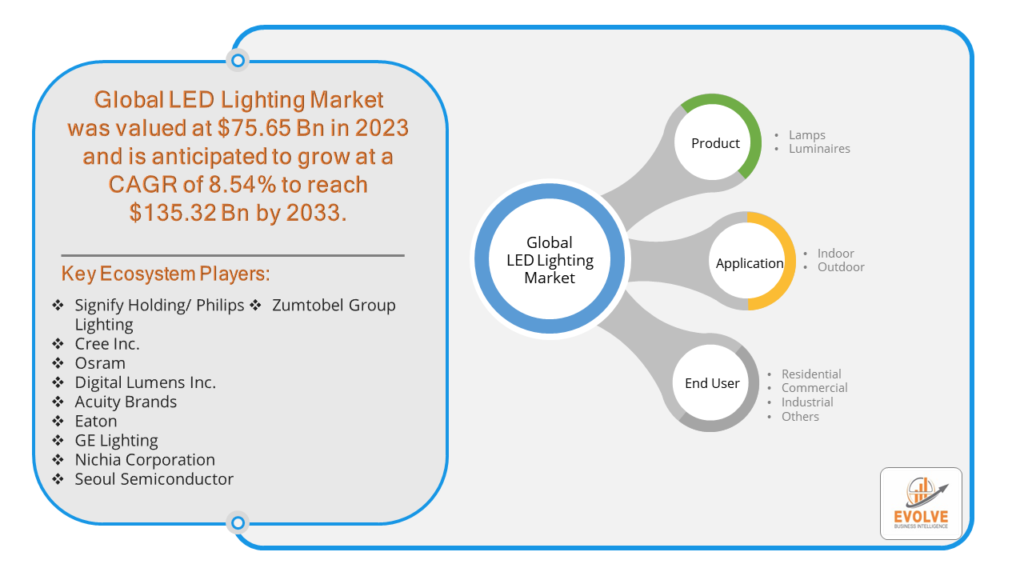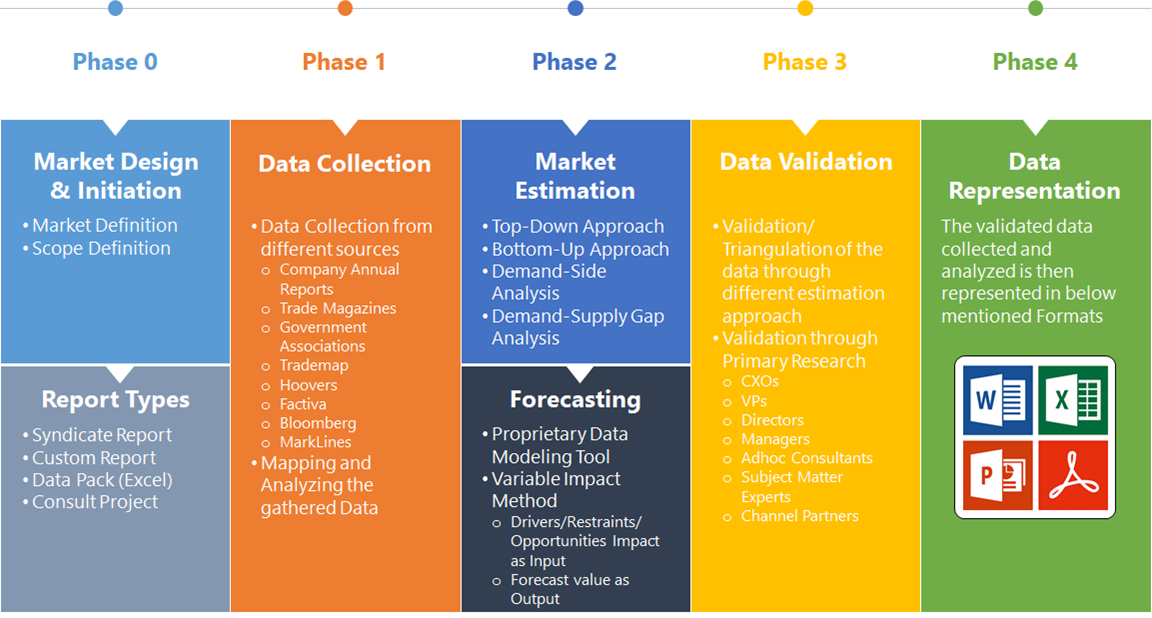LED Lighting Market Overview
The LED Lighting Market Size is expected to reach USD 135.32 Billion by 2033. The LED Lighting industry size accounted for USD 75.65 Billion in 2023 and is expected to expand at a compound annual growth rate (CAGR) of 8.54% from 2023 to 2033. The LED lighting market is a rapidly growing industry with a global market size expected to reach USD 81.48 billion by 2030. In 2022, the market was valued at USD 70.94 billion, with a projected compound annual growth rate of 11.0% from 2023 to 2030. The commercial segment dominated the market in 2022, driven by the demand for LED troffers and downlights. LED luminaires and indoor applications were key market leaders, with North America, Europe, and Asia Pacific being significant regions for market growth.
Global LED Lighting Market Synopsis
The LED Lighting market experienced a positive impact due to the COVID-19 pandemic. The LED lighting market experienced a significant impact from COVID-19, with disruptions in the global supply chain leading to delays and equipment shortages. The pandemic caused a reduction in demand for LED lighting due to suspensions and lockdowns affecting construction sites. However, the industry saw a recovery in the second half of 2021 with increased construction activities, contributing to a steady rebound in the LED lighting sector. Technological advancements, such as IoT integration and smart LED lighting solutions, are driving innovation and growth in the market despite the challenges posed by the pandemic.
Global LED Lighting Market Dynamics
The major factors that have impacted the growth of LED Lighting are as follows:
Drivers:
⮚ Incredibly efficient and environmentally friendly
LED lighting has remarkable efficiency, with rates ranging from 80% to 90% when compared to conventional lighting sources. These lights only generate 20% heat and have a 50,000-hour lifespan. They are also regarded as being extremely environmentally friendly because they don’t emit UV rays or contain harmful materials like mercury.
Restraint:
- Lack of awareness
The governments, as well as corporations, are not completely aware of all the benefits of LED lighting such as energy efficiency, and among others. They are also unaware of how to obtain well- designed LED solutions and continuous developments in LED technology. Updating themselves regularly is also difficult since there are constant innovations in this technology which will hamper the growth of the LED lighting market.
Opportunity:
⮚ Government initiatives
The Electric Lamp and Component Manufacturers Association (ELCOMA) report states that the government intends to switch to LEDs for all street lighting. In a similar vein, commercial establishments are receiving notifications from the government to switch out their downlights for LED ones. The demand for LED lighting will rise in the future as a result of the greater initiative made by the various governments.
LED Lighting Market Segment Overview
By End User
Based on the End User, the market is segmented based on Residential, Commercial, Industrial and Others. In residential applications, LED lighting is popular for its energy efficiency and longevity, offering cost savings and enhanced aesthetics for homeowners. In the commercial sector, businesses adopt LED lighting for its versatility, customizable features, and potential for reducing operational costs through improved energy efficiency and maintenance savings. In industrial settings, LED lighting provides durable, high-performance illumination solutions, enhancing safety, productivity, and operational efficiency in manufacturing facilities, warehouses, and logistics centers.
By Product
 Based on the Product, the market has been divided into Lamps and Luminaires. The luminaries segment dominated the market in 2021 and lamps is projected to be the faster-growing segment during the forecast period, 2022-2030. This is because only troffers, high bays, street lighting fixtures, and track lighting use LED lights. The primary driver of the segment’s growth is the installation of more track lights and light poles as a result of expanding commercial building space and developing smart city initiatives.
Based on the Product, the market has been divided into Lamps and Luminaires. The luminaries segment dominated the market in 2021 and lamps is projected to be the faster-growing segment during the forecast period, 2022-2030. This is because only troffers, high bays, street lighting fixtures, and track lighting use LED lights. The primary driver of the segment’s growth is the installation of more track lights and light poles as a result of expanding commercial building space and developing smart city initiatives.
By Application
Based on Application, the market has been divided into Indoor and Outdoor. The indoor lighting segment dominated the market in 2021 and outdoor lighting segment is projected to be the faster-growing segment during the forecast period, 2022-2030. This is due to the rise in demand from supermarkets, shopping centers, and retail enterprises for high-intensity discharge and fluorescent bulb replacements. LED lighting is less expensive and generates less heat than previous lighting options.
Global LED Lighting Market Regional Analysis
Based on region, the market has been divided into North America, Europe, Asia-Pacific, the Middle East & Africa, and Latin America. The area of Asia-Pacific is anticipated to dominate the market for the usage of LED Lighting, followed by those in North America and Europe.
 LED Lighting Asia-Pacific Market
LED Lighting Asia-Pacific Market
Asia-Pacific dominates the LED Lighting market due to several factors. The LED lighting market was led by Asia Pacific (APAC) in 2019. This is explained by the growing number of smart homes being built, the concomitant developments in technology, and the growing environmental issues. The European Commission predicts that in the upcoming years, APAC will grow at the fastest rate.In recent years, LED lighting has advanced, particularly in Southeast Asia. This is due to the high rates of urbanization in Southeast Asia, which has led to a massive growth in the construction of residential complexes. From 2016 to 2023, the Chinese market is predicted to expand at a CAGR of 35%, a sharp rise. On the other hand, Europe is anticipated to have significant development because of the government’s ban on the use of less efficient lighting, such as CFL, and the incentives and rebates associated with LED installation in the residential and commercial sectors.
LED Lighting North America Market
The North America region has been witnessing remarkable growth in recent years. From 2022 to2030, the North American LED lighting market is anticipated to expand at a notable CAGR. This is because there are a lot of market participants and more people are using LED lights.
Competitive Landscape
The competitive landscape includes key players (tier 1, tier 2, and local) having a presence across the globe. Companies such as Signify Holding/ Philips Lighting, Cree Inc., OSRAM, Digital Lumens Inc., and Acuity Brands are some of the leading players in the global LED Lighting Industry. These players have adopted partnership, acquisition, expansion, and new product development, among others as their key strategies.
Key Market Players:
- Signify Holding/ Philips Lighting
- Cree Inc.
- OSRAM
- Digital Lumens Inc.
- Acuity Brands
- Eaton
- GE Lighting
- Nichia Corporation
- Seoul Semiconductor
- Zumtobel Group
Key development:
In 2019, Signify’s Philips Greenpower LED toplighting compact was launched. In January 2020 they introduced and extended product range that simplifies switch to LED grow lights in greenhouses. Philips Greenpower LED toplighting compact consumes 50% less energy and also reduces running costs due to its high efficiency. It’s extremely suitable for crops which need a lot of light.
Scope of the Report
Global LED Lighting Market, by End User
- Residential
- Commercial
- Industrial
- Others
Global LED Lighting Market, by Product
- Lamps
- Luminaires
Global LED Lighting Market, by Application
- Indoor
- Outdoor
Global LED Lighting Market, by Region
- North America
- US
- Canada
- Mexico
- Europe
- UK
- Germany
- France
- Italy
- Spain
- Benelux
- Nordic
- Rest of Europe
- Asia Pacific
- China
- Japan
- South Korea
- Indonesia
- Austalia
- Malaysia
- India
- Rest of Asia Pacific
- South America
- Brazil
- Argentina
- Rest of South America
- Middle East & Africa
- Saudi Arabia
- UAE
- Egypt
- South Africa
- Rest of Middle East & Africa
| Parameters | Indicators |
|---|---|
| Market Size | 2033: $135.32 Billion |
| CAGR | 8.54% CAGR (2023-2033) |
| Base year | 2022 |
| Forecast Period | 2023-2033 |
| Historical Data | 2021 |
| Report Coverage | Revenue Forecast, Competitive Landscape, Growth Factors, and Trends |
| Key Segmentations | End User , Product, Application |
| Geographies Covered | North America, Europe, Asia-Pacific, Latin America, Middle East, Africa |
| Key Vendors | Signify Holding/ Philips Lighting, Cree Inc., OSRAM, Digital Lumens Inc., Acuity Brands, Eaton, GE Lighting, Nichia Corporation, Seoul Semiconductor, Zumtobel Group |
| Key Market Opportunities | • Developments of emerging countries |
| Key Market Drivers | • Benefits of the LED lights Rising adoption of the LED lighting from indoor and outdoor construction activities
|
REPORT CONTENT BRIEF:
- High-level analysis of the current and future LED Lighting Industry trends and opportunities
- Detailed analysis of current market drivers, restraining factors, and opportunities analysis in the future
- Historical market size for the year 2021, and forecast from 2023 to 2033
- LED Lighting market share analysis for each segment
- Competitor analysis with a comprehensive insight into its product segment, financial strength, and strategies adopted.
- Identifies key strategies adopted by the key players including new product development, mergers and acquisitions, joint ventures, collaborations, and partnerships.
- To identify and understand the various factors involved in the global LED Lighting market affected by the pandemic
- To provide year-on-year growth from 2022 to 2033
- To provide short-term, long-term, and overall CAGR comparison from 2022 to 2033.
- Provide Total Addressable Market (TAM) for the Global LED Lighting Market.





